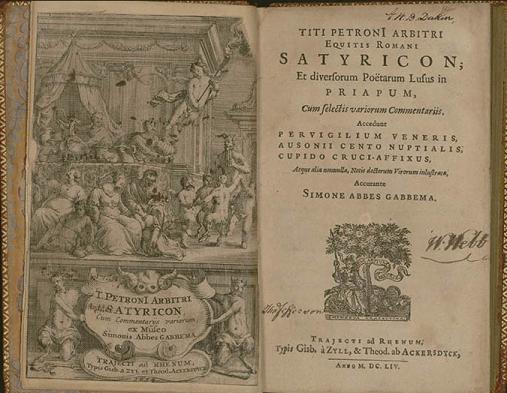Educated homosexuals like to pull out the old Ancient Greco-Roman card that the liberals use. They project their values onto an idealized past that never existed in order to legitimize their lifestyles today.
Judge it by yourself. What could be more decadent in the Greco-Roman world than the homoerotic adventures recounted in a novel written in times of Nero or Caligula? However, classic pederasty was not meant for coeval adults, as is the LGBT movement of today.
Below I include my translation of the prologue by Jacinto Leon Ignacio to one of the Spanish translations of Petronius’ novel (ellipsis omitted between unquoted passages):
Rome,
centuries ago
In the vast and important Greek and Roman literature from which we still live, there are just a few novelists. Maybe for an overwhelming majority of illiterates it would had been much more affordable the theater, which is enough to listen, that the written narrative which must be read. The same was true of poetry and the rhapsodies recited in public.
The fact is that in Greece there are only a few examples of novels, apart of Longus, and from the Romans only Apuleius and Petronius, whose work we offer here.
It appears that, at the time, the Satyricon enjoyed considerable popular success, for both Tacitus and Quintilian commented it in their manuscripts, although it is apparent that neither knew it directly, only from hearsay. It is likely that they did not grant it much literary value because its style and form collided with all the concepts in vogue.
However, the Satyricon was not lost and copies were kept in the Middle Ages, while jealously concealed because of its subject matter [pederasty] and for being the work of a pagan. The work continued to be ignored by the public to the point that only scholars knew its title, but believed it was lost.
Therefore, a scandal broke when, in 1664, appeared the first edition of Pierre Petit.
Soon after, the Satyricon was translated into several languages, including ours, with such success that has made it one of the great bestsellers in history. There were those who sought to take advantage that the work is incomplete, rewriting it to their liking. It was easy nevertheless to expose them.
Presumably, however, the author would not work at top speed like if we should go to a literary prize. He seems to have devoted years to this task. Do not forget that what is now known are only fragments of the original, estimated in twenty books. The author might have started writing when Caligula reigned and Nero followed, to see the publication during the reign of the next emperor. It can be no coincidence that the book mentions contemporary events known to all, or that the author considered worth mentioning many names.
This is a job too conscientious not to be the work of a professional. Moreover, the action does not take place in Rome, but in the provinces and almost none of the men are Latins. It seems as if the author had had an interest in showing the reality of the empire, a reality ignored in the capital.
The novel consists merely of the travel story of [Encolpius] and his servant Gitone through different locations. The incidents, sometimes unrelated, their adventures and the people they encounter are the text of the Satyricon, which lacks a plot as was the style of the epoch. We could actually say that it consists of countless short stories of the two protagonists. This technique influenced many centuries later the books of chivalry, the picaresque and even Don Quixote. Throughout many incidents the author reveals us an extraordinary real view of the life in the Roman provinces, although tinged with irony.
Petronius simply tells us what he saw. In a way, his novel was an approach to realism, leaving aside the epic tone of the tragedies to focus on current issues, as Aristophanes did in Greece. And that was the pattern followed by Petronius. There is a huge difference between his style and that of other contemporary writers.
Poets, despite their undoubted genius, are pompous and in the tragedies the dialogues are extremely emphatic. Petronius by contrast, remains accessible to everyone. He expressed himself in a conversational tone, which justifies the use of a first person that conveys the feeling that someone is telling us a live tale. That’s why today we can read his Satyricon with the same interest of his times and nothing of its freshness is lost.
Writing is, in a sense, a childbirth with the same joys and suffering. Both things must have accompanied Petronius in this trip with [Encolpius] and Gitone through the decline of Rome.

8 replies on “The Satyricon”
The whole point of the above post is that Encolpius was about 25 years old; his servant Gitone, 16. This is not only different of the LGBT movement of today, it is even different of what today is called “pederasty”, where the disparity of ages is more dramatic. Read this hilarious novel to see my point.
Sorry for the OT, but I thought this should be brought to your attention: since you are a fan of Kemp, what do you think of this post on his blog, where he praises Nelson Mandela?
http://www.arthurkemp.com/2013/06/nelson-mandela-nationalist-reappraisal.html
After Kemp wrote his major book he became involved with BNP and, just like the BNP diluted its original message, Kemp followed his party’s steps.
I like Kemp’s books on history, but axiologically he is behind Pierce.
Kemp is suppose to be a great speaker.
Read this: (link) and (link)
Impressive site. I didn’t know it. I’ll link it not to my site in Spanish.
Check it out and if you want, tell us what you think.
Perhaps I would take issue with one of the above-linked articles that implies that no homoeroiticism was accepted in the Greco-Roman world? This novel by Petronius, if it’s indeed a window to the past, seems to refute that view.